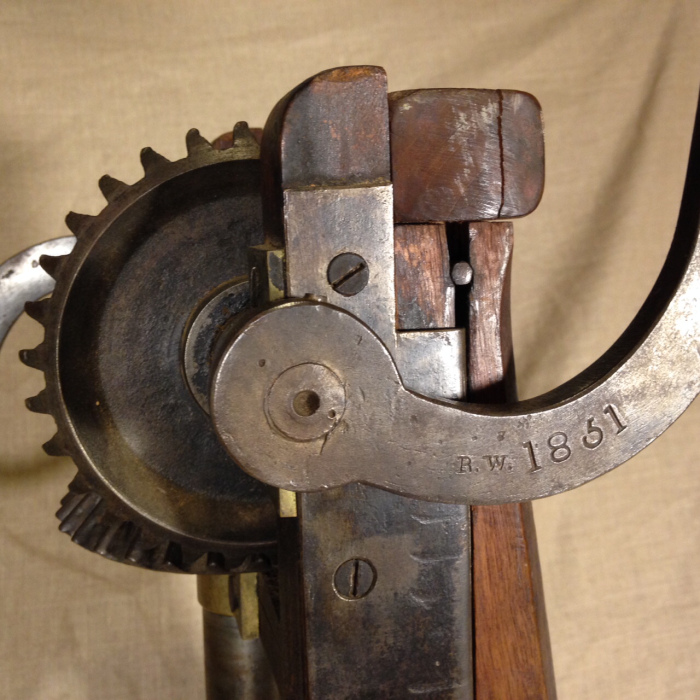
Beam Auger (detail of date and initials), Center Family, Mount Lebanon, NY, Shaker Museum | Mount Lebanon, 2009.1.1. Matthew Kroening, photographer.
In the two previous articles, we discussed a shoemaker’s bench and a pair of worsted combs, all made by Brother Richard Woodrow. In this post we present a tool – a beam auger – that he made and used in his woodworking at the Center Family at Mount Lebanon. On April 13, 1850, a Shaker journalist noted in […]
In the two previous articles, we discussed a shoemaker’s bench and a pair of worsted combs, all made by Brother Richard Woodrow. In this post we present a tool – a beam auger – that he made and used in his woodworking at the Center Family at Mount Lebanon.

Beam Auger, Center Family, Mount Lebanon, NY, Shaker Museum | Mount Lebanon, 2009.1.1. Matthew Kroening, photographer
On April 13, 1850, a Shaker journalist noted in the Center Family journal: “R[ichard] B. W[oodrow] engaged something about building a boring machine &c.” Boring machines, or beam augers, were essential tools for framing heavy timber buildings. The various beams, posts, girts, rafter plates, sills, etc. in a building’s timber frame are connected using mortise and tenon joints – basically square (or most often rectangular) pegs fit into square (or rectangular) holes. Mortises – the holes – were made by drilling a series of one-and-one-half to two-inch round holes in a beam with a large auger. The holes were then fashioned into a rectangle with chisels to make them ready to receive the tenon. The tenon was made to fit in its corresponding mortise by shaping the end of a beam using saws and chisels. In a large building such as a Shaker barn, hundreds of such joints might be required. In the early 1850s, Brother Richard was faced with several timber framing projects – the largest of which was to be a huge new cow barn for the family’s herd. This project could have been the motivation for him to build a new beam auger.
Using the beam auger was pretty straightforward. Once the position for a mortise was marked on the beam, the tool was placed on the beam with the auger bit at one end of the marked out mortise. The timber-framer sat on the leather seat of the beam auger and turned the handles. On Brother Richard’s machine, the two-inch diameter twisted auger bit automatically dug into the beam – advancing deeper and deeper until it reached a pre-set depth at which time, without changing the direction the handles were being turned, the auger bit automatically reversed rotation and withdrew from the beam, returning to its original position. The operator then slid the machine to position the auger bit at the other end of the marked-out mortise and bored another hole. The auger was then positioned several more times to remove as much of wood between the first two holes as possible. With some cleaning up with a chisel the mortise was ready for its tenon. To watch a short demonstration of a commercially made beam auger being used, try this one-minute YouTube demonstration made at a timber framing class at the Maplewood Center for Common Craft in Greenwich, New York.
Brother Richard’s beam auger is more mechanically complex than most commercially made examples. Whether Woodrow was copying some mechanism he had seen elsewhere or whether the reversing feature and pre-set depth adjustment were his own inventions has not been determined. (We welcome comments from any students of mid-19th century beam augers.) Brother Richard stamped the date “1851” and his initials “R. W.” on both metal handles. Unlike the dated worsted combs, which he had no intention of using himself, he may have added his initials to this tool in the tradesmen’s tradition of identifying the tool as the one he used.

Beam Auger (detail of date and initials), Center Family, Mount Lebanon, NY, Shaker Museum | Mount Lebanon, 2009.1.1. Matthew Kroening, photographer.

Beam Auger (detail of depth control), Center Family, Mount Lebanon, NY, Shaker Museum | Mount Lebanon, 2009.1.., Matthew Kroening, photographer.
The beam auger was purchased locally in New Lebanon, New York, by Donald Carpentier, the founder of Eastfield Village, a private teaching museum in East Nassau, New York. Don consigned the auger to Northeast Auctions, Portsmouth, New Hampshire in 2008 and it was purchased at auction by the Shaker Museum.
Although this concludes our three-part discussion about Brother Richard Woodrow and three objects in the Museum’s collection made by him, it is likely he will reappear in a later posting since there are a few more items in the collection associated with his Shaker life and work.